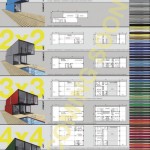 |
Gimbal manufacturer Gudsen has updated its Moza Slypod electronic monopod, adding a longer extension, faster motion and better battery life. The Moza Slypod Pro is essentially a motor-driven monopod that allows videographers to create smooth slider and jib-style camera movements using automatically extending telescopic tubes.
The Slypod Pro can be controlled via the Moza App to extend the telescopic tubes at a given pace to allow mounted cameras to slide across the scene, towards or away from the subject, or to raise or lower the shooting angle. In this new version the range of movement has been increased, allowing a shift from start to finish of up to 53cm/21in, and the speed at which the camera can be moved has been increased to 40mm per second. A further improvement over the previous models is the 4 hour battery life, which can be supplemented with USB power via an external battery pack.
 |
Made of carbon fiber, to keep the weight down, at 1460g it is still heavier than the previous Slypod and Slypod E due to the extra extension, and probably the bigger battery. It can support kit of up to 2kg for horizontal movement and 6kg when being asked to move vertically.
The Slypod can be linked to the Moza Aircross 2 gimbal to allow both devices to be controlled from the same app when the gimbal is mounted on the Slypod, allowing the camera to move in many more directions at the same time.
 |
The Slypod Pro stores at 650mm and extends to a maximum of 1180mm, and comes with an Arca Swiss type mount instead of the Manfrotto mount used on the original Slypod and the E version. The company is launching the Pro version via a Kickstarter campaign that exceeded its very modest funding goal almost immediately. The campaign is offering the Slypod Pro for $ 459, with an estimated shipping date of May 2021. For more information see the Moza Slypod Kickstarter campaign page or the Gudsen Moza website.
Press release
MOZA Announces Launch of Slypod Pro – World’s First Electronically Adjustable Monopod
Imaging solutions experts MOZA, just announced the launch of Slypod Pro – an innovative electronically adjustable monopod for phone and camera photography. This impressive new monopod combines an electric slider & jib arm that lets users capture amazing photos at any angle and with smooth transition effects. Now, there is an affordable way for anyone to achieve professional results easier than ever. Slypod Pro is available now live on Kickstarter. https://www.kickstarter.com/projects/mozaslypodpro/moza-slypod-pro-do-wonders
This impressive new device is more than just a monopod. It’s a 3-in-1 monopod that combines an electronic slider & fully adjustable jib arm that lets users capture amazing photos at any angle and with smooth transition effects. As the world’s first electronic height adjustable monopod, Slypod Pro can be controlled with just one hand. Its motorized slider is internally geared and silky smooth, and extends out 530mm for a total length of 1460mm. It provides rock-steady support for perfectly smooth motion shots and compelling video.
With Slypod Pro, there are no more lost moments. The slider and jib arm can be placed at any angle and camera position. Previously impossible angles become easy to achieve for photos that come to life from new creative perspectives. Users can find the perfect shot by extending the slider in and out for compelling video and high camera angles.
Slypod Pro Redefines motion control when combined with the MOZA Master App other MOZA’s products such as the MOZA AirCross 2 gimbal to capture dynamic motion footage, and seamless cinematic shots with perfect stability.
“Collapsible monopods are a great option when it’s impractical to carry a bulky tripod. Combined with extensions and jib arms, they allow users to capture stable images at a variety of camera angles. At MOZA, our goal with Slypod Pro was to create the ultimate monopod, one that combines the smoothness of an electronic slider with a versatile jib arm for greater control and creativity. Fully electronic, Slypod can be operated with just one hand, or remotely by app. It gives users the features normally found in high-end photography gear, in a compact, portable and affordable option. Slypod Pro redefines the monopod so that you save time, streamline the photo process, and never, ever miss a shot.” Terry Guan, Founder Of MOZA
Sometimes the best photos happen without being behind the camera so the included MOZA Master APP works with smartphone to enable total control of the monopod to operate the motorized slider, perform precise movements at variable speeds and pre-program movements so users can concentrate on creativity instead of setup.
This full-featured monopod is durable and strong but made for portability. With a rigid carbon fiber body, and tri-legged support stand, it works on any surface. When it’s time to leave the studio and capture location shots, or during travel, the monopod collapses to a compact size that is lightweight, easy to carry and fits in a backpack.
SlyPod Pro supports most of the mainstream entry-level or pro-level photo and video cameras and other camera accessories for versatility and professional results and is available now on Kickstarter with special pricing for early adopters. To learn more visit the campaign here: https://www.kickstarter.com/projects/mozaslypodpro/moza-slypod-pro-do-wonders
Note/disclaimer: Remember to do your research with any crowdfunding project before backing it. Pledges to crowdfunding campaigns are not pre-orders. DPReview does not have a relationship with this, or any such campaign, and we publicize only projects that appear legitimate, and which we consider will be of genuine interest to our readers. You can read more about the safeguards Kickstarter has in place on its ‘Trust & Safety’ page.
Articles: Digital Photography Review (dpreview.com)







































You must be logged in to post a comment.